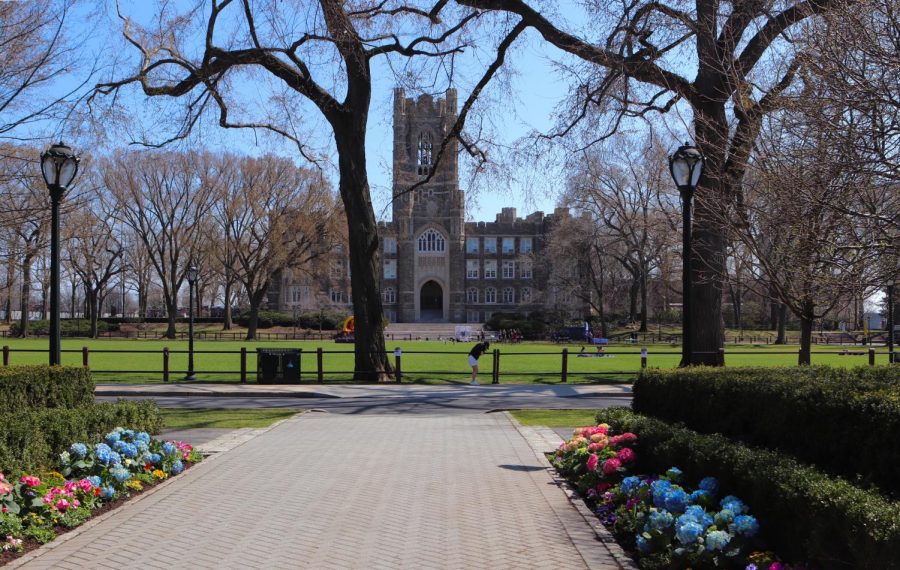Fordham Tuition Increase Reflects Necessary Adjustments
In the midst of a whirlwind of a year, Fordham University is on its feet and bustling along. And, in a move that feels absurd on normal terms yet predictably in-step with 2020, Fordham has raised average tuition by around $2,000. And even then, I don’t think many people saw it coming.
With the decrease in in-person events and the closure of certain facilities like the gym, I, like many other students, was surprised to learn that Fordham increased tuition rates for the 2020-2021 school year. At first, it seemed counterintuitive — after all, most classes are either fully online or in hybrid mode, yet the majority of students are still living on campus and paying for room and board.
This might be understandable if most universities were doing the same, but many universities are trending the other way. Though there’s a stigma that surrounds comparing college stats, for the sake of the argument, take a look at the way U.S. colleges as a whole are approaching finances: Many schools are reducing their tuition by upwards of 20% this year, including Paul Quinn University, National University and Thomas University. A larger array is reducing tuition rates by around 10%, including Princeton University, Johns Hopkins University and Williams College. Some schools, like Southern New Hampshire University, are going so far as to reduce their freshman tuition rates by 100%, which seems unimaginable.
With such a large number of schools significantly decreasing tuition this year, why isn’t Fordham following suit? Even worse, why has it opted for a seemingly cruel increase in tuition?
As with most things in the era of COVID-19, the situation is more nuanced than it may seem. Fordham increased its tuition rates by 3.33% only a few months after a student-led petition to partially refund tuition for the spring 2020 semester reached over 2,000 signatures — ill-timed, to say the least. In fact, the timing might have been comical if it didn’t have to do with an average post-aid cost of a whopping $36,000 (which, the university made clear, was not going to be reimbursed).
As rough as those increases sound, they’re not out of line with the increases in tuition Fordham has made over the past decade. The university has increased their prices by around 3% each year since 2010, so in the grand scheme of things, its 3.3% tuition raise was predictable — consistent, even.
With that being said, if Fordham hasn’t made any drastic changes to the tuition model, does that mean it’ll be smooth sailing for the rest of the year? Not necessarily. The proverbial seas of educational finance are rougher than they seem. Because Fordham has decided to stay open, a significant portion of the extra income from that 3.33% raise goes towards testing and sanitation. Reduced capacity Ram Vans, COVID-19 tests, sanitizer dispensers found (what feels like) every three inches all cost money, and the fact that so many students are online means the university is lacking an immense amount of money in attendance fees.
The central follow-up question to this problem is, consequently: Why doesn’t Fordham go completely virtual? Therein lies the paradox: Fordham, with its relatively small endowment, would be in somewhat of a financial ditch without the money that comes from student housing costs. That doesn’t even include what comes from tuition.
It’s a vicious cycle — while it would cost significantly less money to go completely online, Fordham would lose more money than it would save. So, it’s chosen to stay open. Consequently, it has to pay for health services and facilities (like electricity and glorious air conditioning) while at the same time losing a significant amount of money to students who choose to stay home.
As a resident on campus, the weeks leading up to the start of the semester were, to put it lightly, a harrowing mess of confusion and doubt. Perhaps that’s a bit dramatic, but the truth is I was bombarded with mixed messages left and right, and it was distressing. Trying to gauge whether tuition would change drastically, whether the country’s COVID-19 rates would spike high enough to shut down all universities and whether Fordham would be available for in-person learning was a tiring ordeal. All in all, it was an unpleasant experience.
One of the most confusing moments was when Columbia University decided to go completely online. Several of my peers and I were sure Fordham would follow in its footsteps. The reason our university didn’t do that takes us back to the endowment comparison. Fordham’s endowment is around $730 million. That feels like a lot, but compared to schools like Columbia, Harvard and Johns Hopkins, whose endowments number in the multi-billions, it isn’t much. The point is, many schools that are going completely online are doing so only because they can financially afford to do so.
Now, is it unfortunate that Fordham feels like it has to stay open? Yes, it is unfortunate,for more reasons than one. The safety of the residential students is at stake, along with that of the larger Fordham community. And the fact that tuition isn’t going to be lowered or cut is frustrating. Many of my peers and I feel as if we aren’t getting our money’s worth when it comes to campus activities. Many are also frustrated with having to take the majority of their classes online while living on campus. But, that frustration seems to be a common side effect of, well, being on campus in the first place.
If you are one of the people dealing with that frustration, I ask you to keep this in mind: the COVID-19 era is strange and unforgiving. Many smaller, less-funded universities aren’t just closing for the year — they’re closing for good. As dissatisfying as it is to see tuition prices increase and in-person facilities decrease, imagine the educational landscape without Fordham, which is, at the moment, doing what it can to stay afloat.
The Fordham campus is its own community, its own ecosystem. If the campus were to go fully online (or worse, close), what would happen to those who rely on it? The people who run the available facilities, the employees of the restaurants and the cafeterias, the security personnel and even the students who work on campus, would all be out of a job. Without schools like Fordham to bridge the divide between online and in-person education, the available colleges in America would consist only of massive state schools and small, extremely wealthy private schools. For those who chose to come to Fordham to avoid these aforementioned colleges while still getting a top-tier education, those alternate realities are something Fordham is actively resisting.
To those who feel safer staying home: I’m glad you’re getting the most out of the refunded room charge. To those who feel safer being on campus and paying the full price: I hope you are making the most out of the available spaces. And to those who are in a mix of situations, or who are unhappy about the state of the tuition? Buckle up, stay safe — and if you’ve got an air conditioner, use it.
Hanif Amanullah, FCRH ’24, is an international studies major from Austin, Texas.

Hanif Amanullah is a junior from Austin, Tex., majoring in international studies, whose passion for news writing and multimedia led him to the Ram. Hanif...








































































































































































































